Attractions · Europe · Going Out · Regions · Spain · Western Europe
Get lost! 5 Andalucian pueblos to lose yourself in
Renowned for its pretty white-washed pueblos and characterful cities, Andalucía offers a virtually endless scenic route for cultural and historical explorations. It’s no wonder that many of these villages have maze-like clusters of narrow, irregular streets, given that they were founded thousands of years ago. However, much of this can be attributed to the Moors during their reign of Al-Andaluz. Particularly in the villages nearest the Mediterranean, the confusing configuration of streets and alleyways were meant to deter and protect against raiders from the sea; while the construction of tall buildings on narrow streets was one of their ingenious methods of keeping homes and passageways cool. Today, these characteristics make for some splendid walking routes where the fun lies in getting lost and finding your way back again.
Andalucia is a huge region full of such pueblos; these five are simply a sampling of exemplary cases set in some stunning locations to get you started exploring.
1. Comares, Malaga
The village of Comares sits perfectly perched atop a craggy hilltop at almost 740 metres high, exposing amazing views to the Mediterranean sea and the surrounding mountains. It is, in fact, so easy to get lost in this labyrinthine village that ceramic footprints have been placed along the narrow cobbled streets to help visitors find their way. A wander around will reveal various plaques graphically explaining Comares’ rich history, dating to at least the 3rd century B.C. and including the handover of the village from the Moors to the Catholic Kings in 1487, plus numerous architectural sites also evidencing its Roman and Medieval past. Less than 25km from the coast, Comares is quite accessible though remains somewhat off of the typical tourist route, making it even more quaint and enjoyable.
 2. Arcos de la Frontera, Cadiz
Perhaps better known than Comares, Arcos de la Frontera sits similarly balanced atop the sheer face of a ridge and has a similar maze of streets. In the old town you may also easily lose yourself; however, you’re not likely to lose your bearings in relation to the 15th century castle, Castillo de Arcos, or the 17th century church of San Pedro for long – both rise magnificently from the limestone cliffs. The history of Arcos dates much further back than this, with archeological evidence that the site was inhabited as far back as the Neolithic and Bronze ages. Getting lost in Arcos is like a trip through time, where ruins and more modern palatial architecture stand side by side.
2. Arcos de la Frontera, Cadiz
Perhaps better known than Comares, Arcos de la Frontera sits similarly balanced atop the sheer face of a ridge and has a similar maze of streets. In the old town you may also easily lose yourself; however, you’re not likely to lose your bearings in relation to the 15th century castle, Castillo de Arcos, or the 17th century church of San Pedro for long – both rise magnificently from the limestone cliffs. The history of Arcos dates much further back than this, with archeological evidence that the site was inhabited as far back as the Neolithic and Bronze ages. Getting lost in Arcos is like a trip through time, where ruins and more modern palatial architecture stand side by side.
 3. Casares, Malaga
On the western edge of Malaga Province, just 15 km from the coast, sits the picture perfect little village of Casares. Again with a historic church and Medieval Arab castle rising from a craggy hilltop, the village itself seems to cling to the slopes, rising to meet these monuments at the top. The traditional white-washed buildings stacked higher and higher on top of one another like some impressionist painting. For a village of only about 3,000 inhabitants it has an incredible wealth of historical sites, all easily discovered whilst meandering through the streets en-route to the castle above. It’s a must see as much for a closer inspection as it is for the views over Gibraltar to the Moroccan coast. Yet the village itself is so preciously pretty that you may prefer to lose yourself on the surrounding nature trails for a more distant perspective.
3. Casares, Malaga
On the western edge of Malaga Province, just 15 km from the coast, sits the picture perfect little village of Casares. Again with a historic church and Medieval Arab castle rising from a craggy hilltop, the village itself seems to cling to the slopes, rising to meet these monuments at the top. The traditional white-washed buildings stacked higher and higher on top of one another like some impressionist painting. For a village of only about 3,000 inhabitants it has an incredible wealth of historical sites, all easily discovered whilst meandering through the streets en-route to the castle above. It’s a must see as much for a closer inspection as it is for the views over Gibraltar to the Moroccan coast. Yet the village itself is so preciously pretty that you may prefer to lose yourself on the surrounding nature trails for a more distant perspective.
 4. Alhama de Granada, Granada
Alhama de Granada is a true hidden gem. Resting in rolling, pastoral hills some 50km from Granada, you might pass it by on your way to the city without even noticing. This would be a mistake. Opening up at the far side of town is a deep and fascinating gorge, reminiscent of the “tajo” in Ronda only with far viewer tourists. Though the village has a well preserved Moorish quarter for wandering, the gorge is where you want to lose yourself. Easily accessible trails wind down into the gorge itself, with various points of interest such as an old abandoned mill, and battle sites and a chapel from the Christian reconquest. At the bottom of the gorge, the river that has carved its way through the limestone also provides some refreshing swimming pools for the summer months. Even the Romans prized Alhama for the natural thermal springs bubbling a few kilometres outside of the town, where you can still bathe in a series of natural pools of varying temperature, or inside the formal hammam built alongside the springs.
4. Alhama de Granada, Granada
Alhama de Granada is a true hidden gem. Resting in rolling, pastoral hills some 50km from Granada, you might pass it by on your way to the city without even noticing. This would be a mistake. Opening up at the far side of town is a deep and fascinating gorge, reminiscent of the “tajo” in Ronda only with far viewer tourists. Though the village has a well preserved Moorish quarter for wandering, the gorge is where you want to lose yourself. Easily accessible trails wind down into the gorge itself, with various points of interest such as an old abandoned mill, and battle sites and a chapel from the Christian reconquest. At the bottom of the gorge, the river that has carved its way through the limestone also provides some refreshing swimming pools for the summer months. Even the Romans prized Alhama for the natural thermal springs bubbling a few kilometres outside of the town, where you can still bathe in a series of natural pools of varying temperature, or inside the formal hammam built alongside the springs.
 5. Frigiliana, Malaga
The quintessentially Axarquian village of Frigiliana is aimless wandering at its best. The maze of narrow pedestrian streets may open unexpectedly onto a plaza suddenly teaming with life, or lead you into an apparent dead end only to reveal a cluster of shops and tapas bars. All the while you will marvel at the intricately designed stone pavements and the explosions of floral colour hanging from proudly adorned balconies, window ledges and doorways. Once voted “prettiest village in Andalucía” by the Spanish tourism board, a darker tale explains that here was the final savage defeat of the Moorish uprising in 1569. The remains of the old Arab fort lie in ruins atop the hill at the site of the final battle, but the Moorish influence is more visible throughout the village still today.
5. Frigiliana, Malaga
The quintessentially Axarquian village of Frigiliana is aimless wandering at its best. The maze of narrow pedestrian streets may open unexpectedly onto a plaza suddenly teaming with life, or lead you into an apparent dead end only to reveal a cluster of shops and tapas bars. All the while you will marvel at the intricately designed stone pavements and the explosions of floral colour hanging from proudly adorned balconies, window ledges and doorways. Once voted “prettiest village in Andalucía” by the Spanish tourism board, a darker tale explains that here was the final savage defeat of the Moorish uprising in 1569. The remains of the old Arab fort lie in ruins atop the hill at the site of the final battle, but the Moorish influence is more visible throughout the village still today.
 The list of Andalucían pueblos in which you can happily lose yourself is extensive and I have only scratched the surface here; indeed I have only covered the central coastal provinces. Which additional villages would you recommend?
Alan Hazel is Owner and Director of Cortijo El Carligto.
If you would like to be a guest blogger on A Luxury Travel Blog in order to raise your profile, please contact us.
The list of Andalucían pueblos in which you can happily lose yourself is extensive and I have only scratched the surface here; indeed I have only covered the central coastal provinces. Which additional villages would you recommend?
Alan Hazel is Owner and Director of Cortijo El Carligto.
If you would like to be a guest blogger on A Luxury Travel Blog in order to raise your profile, please contact us.
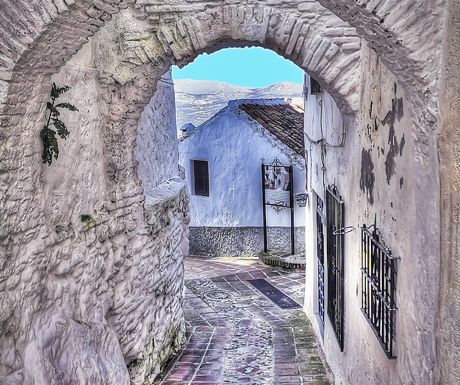 2. Arcos de la Frontera, Cadiz
Perhaps better known than Comares, Arcos de la Frontera sits similarly balanced atop the sheer face of a ridge and has a similar maze of streets. In the old town you may also easily lose yourself; however, you’re not likely to lose your bearings in relation to the 15th century castle, Castillo de Arcos, or the 17th century church of San Pedro for long – both rise magnificently from the limestone cliffs. The history of Arcos dates much further back than this, with archeological evidence that the site was inhabited as far back as the Neolithic and Bronze ages. Getting lost in Arcos is like a trip through time, where ruins and more modern palatial architecture stand side by side.
2. Arcos de la Frontera, Cadiz
Perhaps better known than Comares, Arcos de la Frontera sits similarly balanced atop the sheer face of a ridge and has a similar maze of streets. In the old town you may also easily lose yourself; however, you’re not likely to lose your bearings in relation to the 15th century castle, Castillo de Arcos, or the 17th century church of San Pedro for long – both rise magnificently from the limestone cliffs. The history of Arcos dates much further back than this, with archeological evidence that the site was inhabited as far back as the Neolithic and Bronze ages. Getting lost in Arcos is like a trip through time, where ruins and more modern palatial architecture stand side by side.
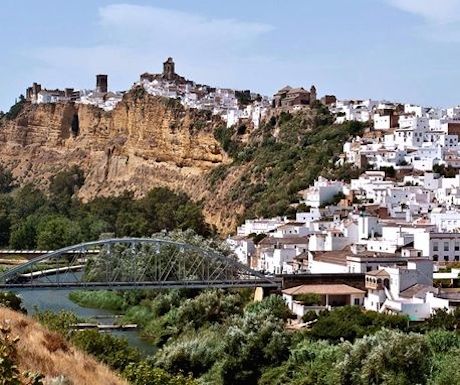 3. Casares, Malaga
On the western edge of Malaga Province, just 15 km from the coast, sits the picture perfect little village of Casares. Again with a historic church and Medieval Arab castle rising from a craggy hilltop, the village itself seems to cling to the slopes, rising to meet these monuments at the top. The traditional white-washed buildings stacked higher and higher on top of one another like some impressionist painting. For a village of only about 3,000 inhabitants it has an incredible wealth of historical sites, all easily discovered whilst meandering through the streets en-route to the castle above. It’s a must see as much for a closer inspection as it is for the views over Gibraltar to the Moroccan coast. Yet the village itself is so preciously pretty that you may prefer to lose yourself on the surrounding nature trails for a more distant perspective.
3. Casares, Malaga
On the western edge of Malaga Province, just 15 km from the coast, sits the picture perfect little village of Casares. Again with a historic church and Medieval Arab castle rising from a craggy hilltop, the village itself seems to cling to the slopes, rising to meet these monuments at the top. The traditional white-washed buildings stacked higher and higher on top of one another like some impressionist painting. For a village of only about 3,000 inhabitants it has an incredible wealth of historical sites, all easily discovered whilst meandering through the streets en-route to the castle above. It’s a must see as much for a closer inspection as it is for the views over Gibraltar to the Moroccan coast. Yet the village itself is so preciously pretty that you may prefer to lose yourself on the surrounding nature trails for a more distant perspective.
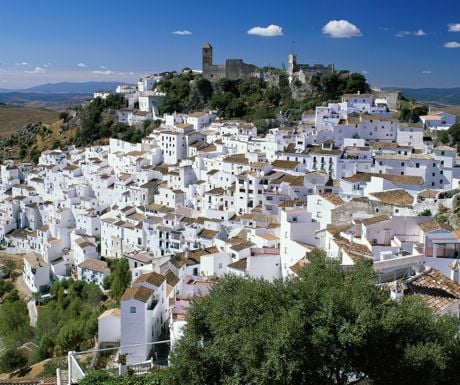 4. Alhama de Granada, Granada
Alhama de Granada is a true hidden gem. Resting in rolling, pastoral hills some 50km from Granada, you might pass it by on your way to the city without even noticing. This would be a mistake. Opening up at the far side of town is a deep and fascinating gorge, reminiscent of the “tajo” in Ronda only with far viewer tourists. Though the village has a well preserved Moorish quarter for wandering, the gorge is where you want to lose yourself. Easily accessible trails wind down into the gorge itself, with various points of interest such as an old abandoned mill, and battle sites and a chapel from the Christian reconquest. At the bottom of the gorge, the river that has carved its way through the limestone also provides some refreshing swimming pools for the summer months. Even the Romans prized Alhama for the natural thermal springs bubbling a few kilometres outside of the town, where you can still bathe in a series of natural pools of varying temperature, or inside the formal hammam built alongside the springs.
4. Alhama de Granada, Granada
Alhama de Granada is a true hidden gem. Resting in rolling, pastoral hills some 50km from Granada, you might pass it by on your way to the city without even noticing. This would be a mistake. Opening up at the far side of town is a deep and fascinating gorge, reminiscent of the “tajo” in Ronda only with far viewer tourists. Though the village has a well preserved Moorish quarter for wandering, the gorge is where you want to lose yourself. Easily accessible trails wind down into the gorge itself, with various points of interest such as an old abandoned mill, and battle sites and a chapel from the Christian reconquest. At the bottom of the gorge, the river that has carved its way through the limestone also provides some refreshing swimming pools for the summer months. Even the Romans prized Alhama for the natural thermal springs bubbling a few kilometres outside of the town, where you can still bathe in a series of natural pools of varying temperature, or inside the formal hammam built alongside the springs.
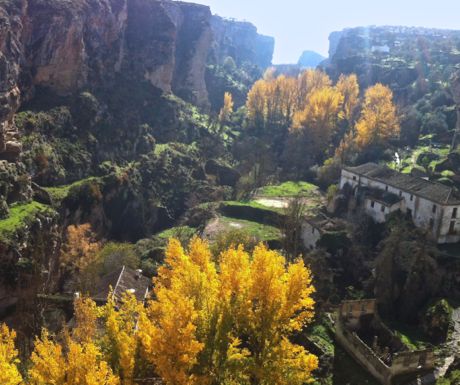 5. Frigiliana, Malaga
The quintessentially Axarquian village of Frigiliana is aimless wandering at its best. The maze of narrow pedestrian streets may open unexpectedly onto a plaza suddenly teaming with life, or lead you into an apparent dead end only to reveal a cluster of shops and tapas bars. All the while you will marvel at the intricately designed stone pavements and the explosions of floral colour hanging from proudly adorned balconies, window ledges and doorways. Once voted “prettiest village in Andalucía” by the Spanish tourism board, a darker tale explains that here was the final savage defeat of the Moorish uprising in 1569. The remains of the old Arab fort lie in ruins atop the hill at the site of the final battle, but the Moorish influence is more visible throughout the village still today.
5. Frigiliana, Malaga
The quintessentially Axarquian village of Frigiliana is aimless wandering at its best. The maze of narrow pedestrian streets may open unexpectedly onto a plaza suddenly teaming with life, or lead you into an apparent dead end only to reveal a cluster of shops and tapas bars. All the while you will marvel at the intricately designed stone pavements and the explosions of floral colour hanging from proudly adorned balconies, window ledges and doorways. Once voted “prettiest village in Andalucía” by the Spanish tourism board, a darker tale explains that here was the final savage defeat of the Moorish uprising in 1569. The remains of the old Arab fort lie in ruins atop the hill at the site of the final battle, but the Moorish influence is more visible throughout the village still today.
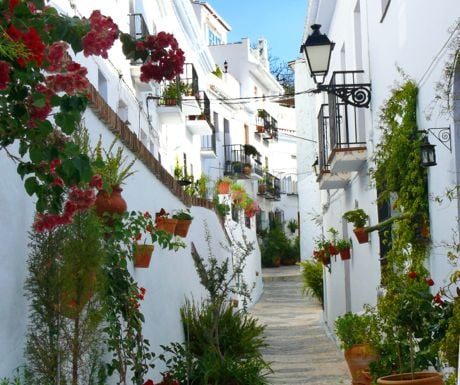 The list of Andalucían pueblos in which you can happily lose yourself is extensive and I have only scratched the surface here; indeed I have only covered the central coastal provinces. Which additional villages would you recommend?
Alan Hazel is Owner and Director of Cortijo El Carligto.
If you would like to be a guest blogger on A Luxury Travel Blog in order to raise your profile, please contact us.
The list of Andalucían pueblos in which you can happily lose yourself is extensive and I have only scratched the surface here; indeed I have only covered the central coastal provinces. Which additional villages would you recommend?
Alan Hazel is Owner and Director of Cortijo El Carligto.
If you would like to be a guest blogger on A Luxury Travel Blog in order to raise your profile, please contact us.Did you enjoy this article?
Receive similar content direct to your inbox.


These are some great places to keep in mind for a future trip to Spain. I particularly like the look of Comares.